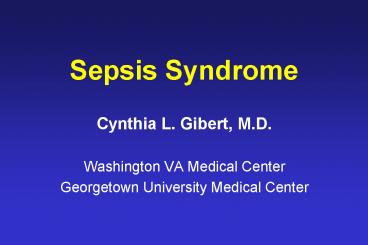Sepsis Syndrome PowerPoint PPT Presentation
1 / 31
Title: Sepsis Syndrome
1
Sepsis Syndrome
- Cynthia L. Gibert, M.D.
- Washington VA Medical Center
- Georgetown University Medical Center
2
Sepsis and Septic Shock
- 13th leading cause of death in U.S.
- 500,000 episodes each year
- 35 mortality
- 30-50 culture-positive blood
3
Mortality Percentage
UIHC SICU
UIHC Candida
UIHC CNS
UVA Enterococcus
UVA newborn ICU
Johns Hopkins
UVA Hospital
0 10 20 30 40 50 60
4
Stages of SepsisConsensus Conference Definition
- Systemic Inflammatory Response Syndrome
(SIRS)Two or more of the following - Temperature of gt38oC or lt360C
- Heart rate of gt90
- Respiratory rate of gt20
- WBC count gt12 x 109/L or lt4 x 109/L or 10
immature forms (bands) - SepsisSIRS plus a culture-documented infection
- Severe SepsisSepsis plus organ dysfunction,
hypotension, or hypoperfusion(including but not
limited to lactic acidosis, oliguria, or acute
mental status changes) - Septic ShockHypotension (despite fluid
resuscitation) plus hypoperfusion
5
Multiple Organ Dysfunction Syndrome
- Dysfunction of 2 or more systems
- Four or more systems - mortality near to 100
percent
6
(No Transcript)
7
(No Transcript)
8
Factors Associated with Highest Mortality
- Respiratory gt abdominal gt urinary
- Nosocomial infection
- Hypotension, anuria
- Isolation of enterococci or fungi
- Gram-negative bacteremia, polymicrobial
- Body temperature lower than 38C
- Age greater than 40
- Underlying illness cirrhosis or malignancy
9
Predisposing Underlying Diseases
- Heart disease-rheumatic or congenital
- Splenectomy
- Intraabdominal sepsis
- Septic abortion or pelvic infection
- Intravenous drug abuse
- Immunocompromised
10
Organisms Responsible for Septic Shock in
Relation to Host Factors
11
(No Transcript)
12
Bacteremia in the Preantibiotic Era
- Streptococcus pneumoniae
- Group A streptococcus
- Staphylococcus aureus
- Haemophilus influenzae
- Neisseria mennigitidis
- Salmonella spp.
13
Emergence of Gram-Negative Organisms
- Antibiotic pressure on normal flora
- Use of invasive devices
- Immune suppression
14
Differential Diagnosis of Fever and Shock
- Purulent bacterial pericardial effusion
- Peritonitis
- Pneumonia with severe hypoxia
- Mediastinitis
- Anaphylaxsis
- Staphylococcal toxic shock syndrome
- Streptococcal toxic shock syndrome
15
Clinical Manifestations
- Fever, chills, hypotension
- Hypothermia, especially in the elderly
- Hyperventilation - respiratory alkalosis
- Diaphoresis, apprehension, change in mental status
16
History
- Community versus hospital-acquired
- Prior or current medications
- Recent manipulations or surgery
- Underlying diseases
- Travel history
17
Approach to Septic Patient
- Seek primary site of infection
- Direct therapy to primary site
- Repeated examination
18
Skin
- Furuncles, cellulitis, bullous lesions
- Intravenous sites, phlebitis
- Erythema multiforme
- Ecchymotic or purpuric lesions
- DIC, petechiae
- Ecthyma gangrenosum
- Purpura fulminans
19
Cardiovascular Signs
- Warm shock - ? CO, ? SVR
- Cold shock - ? CO, ? SVR
- Anaerobic metabolism - lactic acidemia
- Myocardial depressant factor - ??
20
Pulmonary Signs
- Tachypnea
- Hyperventilation, respiratory alkalosis
- ARDS, respiratory failure
- Ventilation-perfusion mismatch
- Widened alveolar-arterial oxygen gradient
- Reduced lung compliance
21
Hematologic Findings
- Neutrophilic leukocytosis
- Leukemoid reaction
- Neutropenia
- Thrombocytopenia
- Toxic granulations
- DIC
22
Renal and Gastrointestinal Signs
- Acute tubular necrosis, oliguria, anuria
- Upper GI bleeding
- Cholestatic jaundice
- Increased transaminase levels
- Hypoglycemia
23
Acute Physiology and Chronic Health Evaluation
- APACHE II
- Temp Arterial pH
- MAP Serum Na Serum Cr
- Heart rate Hematocrit
- Resp. rate WBC
- Oxygenation Glasgow Coma Score
- Acute physiology score Age Chronic health
points
24
Laboratory Studies
- Blood cultures
- Infected secretions/body fluids
- Stool for WBC, C. difficile
- Aspirate advancing edge of cellulitis
- Skin biopsy/scraping
- Buffy coat
25
Therapy of Septic Shock
- Correct pathologic condition
- Optimize intravascular volume
- Administer empiric antimicrobial therapy
- Administer vasoactive drugs
26
Failure of Fluid Replacement and Vasopressors
- acidosis - pHlt7.3
- hypocalcemia
- adrenal insufficiency
- hypoglycemia
27
Empiric Antimicrobial Regimens for Sepsis Syndrome
- Community-acquired non-neutropenic
- Urinary tract 3rd generation cepholosporin,
piperacillin, quinolone AG - Non-urinary tract 3rd generation cepholosporin
metronidazole, ?-lactam/ ?-lactamase inhibitor
AG
28
- Hospital-acquired
- Nonneutropenic 3rd generation cephalosporin
metronidazole, ?-lactam / ?-lactamase inhibitor,
menopenem all AG - Neutropenic Timentin AG, meropenem AG
ceftazidime metronidazole AG
29
Septic ShockOutcomes for Patients on Hospital
Wards versus ICUs
- Ward patients Delays in ICU transfer (67 mins.)
- IV fluid boluses (27 vs 15 mins.)
- Inotropic agents (310 vs 22.5 mins)
- Mortality Wards (70) vs ICUs (39)
- Apache II scores (18.5 vs 24)
- Candidemia
JS Lunberg, Crit. Care Med. 261020 1998
30
Immunotherapies for Septic Shock
- Corticosteroids
- Antiendotoxin monoclonal antibodies E-5, HA-1A
- Anti-TNF antibodies
- IL-1 receptor antagonists
31
Other Treatment Modalities
- Granulocyte transfusions
- Recombinant colony-stimulating factors
- Diuretics
- Pentoxifylline, ibuprofen, naloxone
- Oral nonabsorbable antimicrobial agents

